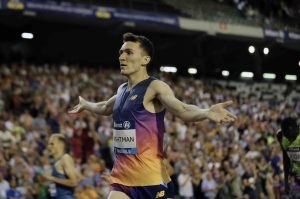JAKE WIGHTMAN- FROM BOY TO MAN
IN THE SECOND OF A TRILOGY, MATT LONG HAS A FRONT-ROW SEAT IN WATCHING GEOFF WIGHTMAN MOVE THROUGH THE COACHING GEARS:
RelatedPosts
In the first of a three-part series, we explored the coaching journey of Geoff Wightman which saw his son Jake take the World 1500m title in Oregon back on 19th July last year. The underlying principle of ‘earning the right to progress’ seems to have been central to the long-term athlete development of Wightman junior. In this second piece, we work back to Jake’s junior career to explore the type of sessions which moved him from a promising junior to an international athlete.
The Tired Surge
In his 2005 book High-Performance Middle Distance Running, the late English national coach for middle distance running, Dave Sunderland, coined the notion of the ‘tired surge’. This notion is to express the idea that a single interval can be split and contain some kind of differential element. In the case of the ‘tired surge,’ this ordinarily involves a ‘float’ element which is affected by the said athlete at a slightly faster than jogging pace. For the observing coach, the ‘float’ element of an interval may not necessarily need to be timed according to stopwatch split but may well be judged by the naked eye in terms of whether the said athlete is moving biomechanically as a ‘steady runner’ rather than as a ‘jogger’.
In bridging from promising teenage athlete and European Junior 1500m champion back in 2013 to international senior, Jake Wightman effected intervals with a float element. Typically the first part of the interval would be longer and more aerobically dominant than the latter ‘post float’ element. Here’s an example:
5 x 600m fast; 200m float; 400m fast (400m jog).
One of the ways of progressing the above session is to (a) retain the 200m float element; (b) to retain the 400 jog element at the end of each interval and (c) to diversify the length of the first component of the intervals. Take the following example.
900m fast; 200m float; 200m fast; (400m jog)
700m fast; 200m float; 200m fast; (400m jog)
4 x 500m fast; 200m float; 200m fast (400m jog)
A way of progressing the session above would be to introduce what Wightman senior refers to as a ‘double float’ element. For example:
5 x 600m fast; 100m float; 300m fast; 100m float; 100m fast (400m jog)
Once again the above can be diversified and progressed by operating over different lengths of interval thus allowing the athlete to run at a range of differential paces.
3 x 600m fast; 100m float; 200m fast; 100m float (400m jog)
3x 500m fast; 200 float; 100m fast; 100m float (400m jog).
We now move on to unpick some of the coach education principles which underpin the above sessions.
Principles
The idea of a ‘float’ element within intervals has received endorsement from the groundbreaking research of the Oregon-based coach Peter J. Thompson who has done much to enhance our understanding of the notion of the ‘lactate shuttle’ (see thenewintervaltraining.com). This was originally conceptualized by Dr. G.A. Brooks in 1986 to describe the dynamic action of lactate as a metabolite moving about within muscles and the circulatory system in order to provide the body with metabolic energy. In simple terms the float recovery facilitates the use of lactate as a productive source of energy, hence the value of the ‘tired surge’ as a mode of interval training.

Whilst a floating element can be retained in speed endurance work in the summer, in order for the intervals to be turned into repetitions and run faster with greater demands on the lactate energy system, athletes like Wightman may choose to substitute an active jog recovery over 400m which may take up to 2 minutes, with a more passive 2-3 minute walk. This, of course, makes the session less aerobically dominant compared to a session in the winter months but may of course be suitable in the pre-competition and competition phases of a periodization cycle.
The above leaves us with a number of questions for self-reflection.
Questions for self-reflection:
- Why might my training benefit from ‘split intervals’ which contain some kind of differential component?
- What is my understanding of how more specifically ‘tired surges’ can help my development as an athlete?
- How can I ‘earn the right to progress’ in terms of diversifying my interval training so that I am faithful to the principles of progressive overload?
In the third and final piece, we regress further to look at how Jake Wightman was guided as he began his journey as an event group middle-distance athlete in his mid-teens.
Matt Long served as an England Team Coach @ the Birmingham 2022 Commonwealth Games Development Camp and welcomes contact through mattlongcoach@gmail.com























